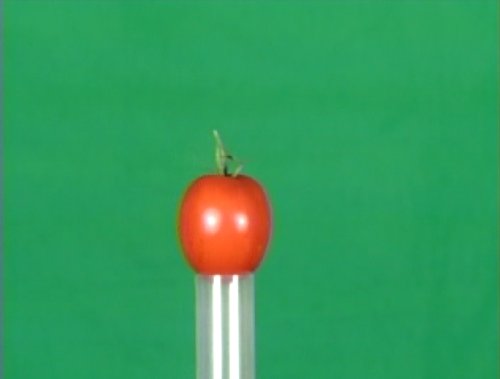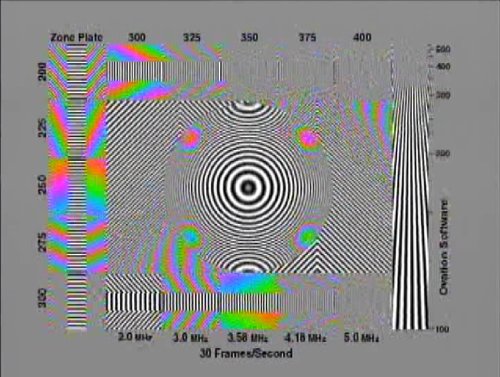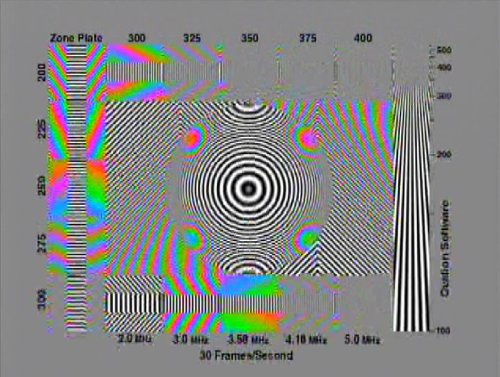The New Theater 650 TV Tuner Solution from ATI
by Josh Venning on June 14, 2006 4:00 AM EST- Posted in
- Smartphones
- Mobile
Image and Video Quality
Probably the most subjective yet important element of a TV tuner card is its ability to play and record high quality video. There are many factors involved in determining how good the video quality is and certain things like sharpness can be good or bad depending on user preference. That's why it's nice that ATI has added more user control over this and other aspects of image quality through the new software with the Theater 650.
ATI provided us with a DVD that contains some test videos to compare image quality between these three cards. To allay any suspicions of foul play, these test videos were created by SMPTE (the Society of Motion Picture and Television Engineers) for the express purpose of testing analog television quality. These videos include still and moving images to test how well a tuner applies things like sharpness and noise reduction. We recorded all of the tests with each of the tuners to provide a consistent test video for comparison between cards, and you can download the complete videos using your favorite BitTorrent client. (Total size of the three videos is 345 MB.) Note that we used ATI's AVIVO utility to convert all of the files to MPEG-4 format from the default MCE .ms MPEG-2 format. This was done to reduce file size, and we did verify that there was no discernible change in image quality (the original files totaled over 1 GB in size). In order to avoid any errors in our own analysis, we used the original files while drawing our conclusions.
It is also important to point out that we didn't just run a DVD player straight into a composite video input. We ran our DVD player through a modulator set up to output on channel 3. This way were were able to provide each card with a source data in the same format as if the images were broadcast and recieved over a cable connection. Feeding in analog video directly would bypass the tuner and demodulator on the card and wouldn't present a full test of the hardware, but our solution gives us the ability to repeat tests easily using a reliable source. The images below are taken from the original video files.
As we mentioned in the introduction, ATI has improved their 3D comb filter with the Theater 650 over the 550 by making it motion adaptive. This means that moving objects will be much cleaner and sharper compared to those without this feature. As you can see in the above images, the fruit in the Theater 650 capture looks similar to the 550, but the color is cleaner, especially near the edges of the tomato. You can also see that the DualTV has some problems with displaying the edges of the tomato and stand properly while in motion. This is one case where we see a clear improvement by ATI over NVIDIA in image quality.
In the above images, we can also see how there is slightly more detail in certain areas of the test pattern with the Theater 650 compared to the 550, and both are ahead of the DualTV. The loss of detail is noticeable near the upper and lower right hand corners of the image where some of the fine lines tend to blur together. There are also fewer color artifacts with the Theater 650 due to its higher quality 3D comb filter.
As a final example, we can see the difference in the color between the Theater 650 and 550 in these images, and the 650 gives the woman's skin tones a better treatment. There isn't a very big difference here between the Theater 650 and DualTV but you can see how the colors are generally brighter on the Theater 650 due to the new automatic color control.
These are only some of the tests on the DVD (there are eight tests in all) which demonstrate the Theater 650's better overall image quality than the 550. From these results we can definitely see how ATI has improved over the 550 as well the DualTV with their new Theater card.
Probably the most subjective yet important element of a TV tuner card is its ability to play and record high quality video. There are many factors involved in determining how good the video quality is and certain things like sharpness can be good or bad depending on user preference. That's why it's nice that ATI has added more user control over this and other aspects of image quality through the new software with the Theater 650.
ATI provided us with a DVD that contains some test videos to compare image quality between these three cards. To allay any suspicions of foul play, these test videos were created by SMPTE (the Society of Motion Picture and Television Engineers) for the express purpose of testing analog television quality. These videos include still and moving images to test how well a tuner applies things like sharpness and noise reduction. We recorded all of the tests with each of the tuners to provide a consistent test video for comparison between cards, and you can download the complete videos using your favorite BitTorrent client. (Total size of the three videos is 345 MB.) Note that we used ATI's AVIVO utility to convert all of the files to MPEG-4 format from the default MCE .ms MPEG-2 format. This was done to reduce file size, and we did verify that there was no discernible change in image quality (the original files totaled over 1 GB in size). In order to avoid any errors in our own analysis, we used the original files while drawing our conclusions.
It is also important to point out that we didn't just run a DVD player straight into a composite video input. We ran our DVD player through a modulator set up to output on channel 3. This way were were able to provide each card with a source data in the same format as if the images were broadcast and recieved over a cable connection. Feeding in analog video directly would bypass the tuner and demodulator on the card and wouldn't present a full test of the hardware, but our solution gives us the ability to repeat tests easily using a reliable source. The images below are taken from the original video files.
As we mentioned in the introduction, ATI has improved their 3D comb filter with the Theater 650 over the 550 by making it motion adaptive. This means that moving objects will be much cleaner and sharper compared to those without this feature. As you can see in the above images, the fruit in the Theater 650 capture looks similar to the 550, but the color is cleaner, especially near the edges of the tomato. You can also see that the DualTV has some problems with displaying the edges of the tomato and stand properly while in motion. This is one case where we see a clear improvement by ATI over NVIDIA in image quality.
In the above images, we can also see how there is slightly more detail in certain areas of the test pattern with the Theater 650 compared to the 550, and both are ahead of the DualTV. The loss of detail is noticeable near the upper and lower right hand corners of the image where some of the fine lines tend to blur together. There are also fewer color artifacts with the Theater 650 due to its higher quality 3D comb filter.
As a final example, we can see the difference in the color between the Theater 650 and 550 in these images, and the 650 gives the woman's skin tones a better treatment. There isn't a very big difference here between the Theater 650 and DualTV but you can see how the colors are generally brighter on the Theater 650 due to the new automatic color control.
These are only some of the tests on the DVD (there are eight tests in all) which demonstrate the Theater 650's better overall image quality than the 550. From these results we can definitely see how ATI has improved over the 550 as well the DualTV with their new Theater card.



















78 Comments
View All Comments
Egglick - Wednesday, June 14, 2006 - link
I don't know about you guys, but I'm not as convinced as the reviewer that the 650 has better image quality. It's clearly got better color than the 550, but I see alot more noise and artifacts. Take a look at the top corners of the tomato, and the added noise (around everything) in the test pattern. This is likely due to the "edge enhancement" feature, but that should've been turned off before running tests like this.I also agree that there should have been a Hauppauge card included, as well as alot more discussion on the DTV features of the card.
BigLan - Wednesday, June 14, 2006 - link
It could also be that the 550 setup was using an MPEG2 setting with a lower bitrate than the 650 or Nvidia card. Nothing about that was mentioned, but hopefully they'll have chosen the same on each system.Actually a comparison using different quality settings would have been very nice to have seen, as reportedly the dual tuner produces a better picture at a lower bitrate than other cards. This can be an important feature for some consumers who are willing to trade off some PQ and record at 1 GB/hour rather than 3 or 4 GB to get much longer recording time from their PVR.
I'll also note that no system specs were given either. Are we looking at a 2.4ghz p4, X2 or Conroe system here? Other comments have covered the lack of HDTV testing.
Lastly - the Hauppauge 150 is actually better than the 250. I don't think anand has ever looked at it, so I don't know how they would know the quality of it. While the 150 is cheaper than the 250, it is a newer, better card.
Araemo - Wednesday, June 14, 2006 - link
CPU Usage numbers are fairly useless without knowing what CPU the test system is running.100% usage on a p3 is going to be noticeably less annoying on an FX-60(And will max out at '50%', since it will only use 1 core... I know there is only one graph showing in task manager, but task manager has the option of showing only one graph no matter how many CPUs you have, so that isn't really definitive.)
If you guys did say what CPU it is(and what the whole system is?), I missed it.
Squidward - Wednesday, June 14, 2006 - link
Did you guys get to use the new Catalyst Media Center software at all? I've been curious how it compares to the old MMC software that's had the same nappy interface since 1995.Mumrik - Wednesday, June 14, 2006 - link
Why didn't you touch on the hardware DRM engine that's mentioned in ATi's press release?A lot of us really want to know what the heck they're up to with that...
pjladyfox - Wednesday, June 14, 2006 - link
I was wondering this myself since it will factor greatly into the purchase of any tuner hardware.archcommus - Wednesday, June 14, 2006 - link
Would you say the improved image quality is worth selling my 550 card for?DigitalFreak - Wednesday, June 14, 2006 - link
I want a card with dual ATSC tuners! There's a company with a reference design out for a year or more, yet no one is making this type of card.Chadder007 - Wednesday, June 14, 2006 - link
No QAM support....No Care.AlexWade - Wednesday, June 14, 2006 - link
No HDTV support....No care.Seriously, when are ATI and NVidia going to realize regular TV is going to be cut off soon? We have less than 3 years to go all digital, and new SDTV cards keep coming out. Brilliant.